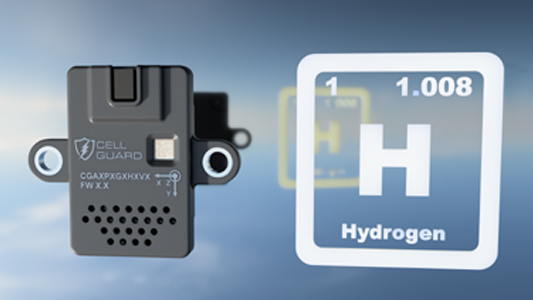Bristol, UK: Metis Engineering, a leader in battery safety and monitoring innovations, proudly announces the launch of its latest breakthrough: Cell Guard with Hydrogen. This new sensor, a sophisticated evolution of the original Cell Guard, is expertly engineered to detect hydrogen (H₂) in energy storage systems, offering essential safety enhancements for hydrogen-based applications and battery packs alike.
Why is Hydrogen Dangerous? In air hydrogen has a wide flammability limit from 4 to 77% by volume and an explosive limit from 18 to 59%. The activation energy for ignition is extremely low and can be triggered by a very small spark or static discharge. Hydrogen is an odourless, colourless gas and can go undetected without specialised technology.
Early detection of hydrogen leaks is critical to maintaining safety across the hydrogen lifecycle—from production to storage, transport, usage in fuel cells and H2 ICE. With applications spanning transport, marine, aviation, and industrial sectors, Metis Engineering’s new sensor meets this critical need, creating new benchmarks for safety in hydrogen technologies.
The latest hydrogen detection sensor addresses key safety needs with innovative, high-performance features, advancing on the foundation of the original Cell Guard sensor:
- Reliable Hydrogen Storage Leak Detection: This sensor offers unparalleled accuracy in identifying even trace hydrogen leaks, ensuring compliance with the strictest safety standards and protecting against fire or explosion risks in hydrogen storage systems.
- Electrolysis Detection in Fuel Cells and Battery Packs: moisture ingress can lead to electrolysis, producing dangerous gases. Metis Engineering’s sensor detects early signs of hydrogen generation.
- Enhanced Detection in High-VOC Environments: Cell Guard with Hydrogen excels in environments with high volatile organic compound (VOC) levels. For example, where large amounts of adhesive have been used in the construction of an Energy Storage System, ambient levels of VOC can remain very high; this sensor can still detect thermal runaway.
- Wider Temperature Range Compatibility: With an expanded operational range of -40°C to +85°C (-40°F to +185°F), this sensor is built for extreme conditions, where other sensors may underperform, making it ideal for diverse, demanding environments.
- Ultra-Low Power Consumption: Operating in low power mode, Cell Guard with Hydrogen ensures continuous monitoring with little energy drain (<1mA). On detection of a level that matches a preconfigured threshold Cell Guard with Hydrogen will wake the CAN interface and toggle a Low Side Drive pin, providing power efficient detection of hydrogen leaks and water ingress.
- Instantaneous Measurement Upon Startup: The sensor delivers immediate hydrogen measurements without the need for warm-up, ensuring real-time safety monitoring from power-up.
- Wide Accurate Detection Range of 0% to 20% H₂: The sensor measures hydrogen with precision across a wide range, offering dependable data in variable conditions.
“We’re excited to introduce this advanced sensor, addressing critical safety concerns in hydrogen storage and battery management systems,” said Joe Holdsworth, CEO of Metis Engineering. “Our aim is to equip customers with forward-thinking solutions that elevate safety and enhance the resilience of their energy storage infrastructure.”
The new hydrogen leak detection sensor is now open for pre-orders, with deliveries from 15th October 2024. For further information on this product or integration possibilities, please visit metisengineering.com.












